Australian Accounting and Finance: Telstra and Woolworths Report
VerifiedAdded on 2022/11/02
|15
|3257
|234
Report
AI Summary
This report provides a comprehensive analysis of accounting and finance practices in Australia, focusing on two major companies: Telstra Group and Woolworths Group. The introduction offers background information on both companies, detailing their business operations, market position, and financial performance. Task 1 presents a comparative analysis of the equity and liabilities of both companies over three years (2017-2019), highlighting key trends in share capital, reserves, retained earnings, and non-controlling interests for equity, and borrowings, payables, employee benefits, and provisions for liabilities. The analysis includes detailed financial data, identifying significant changes and patterns in each company's financial structure. Task 2 explores the concept of reporting entities under Australian Securities Law, differentiating between general-purpose financial reports (GPFR) and special-purpose financial reports, and discussing the implications for various stakeholders. It also explains the criteria for classifying proprietary companies as small or large, based on the Corporations Act 2001, and the associated reporting requirements and thresholds. The report concludes by summarizing the key findings regarding the sources of funds for both Telstra and Woolworths, emphasizing the importance of long-term debt and share issuance in their financial strategies.
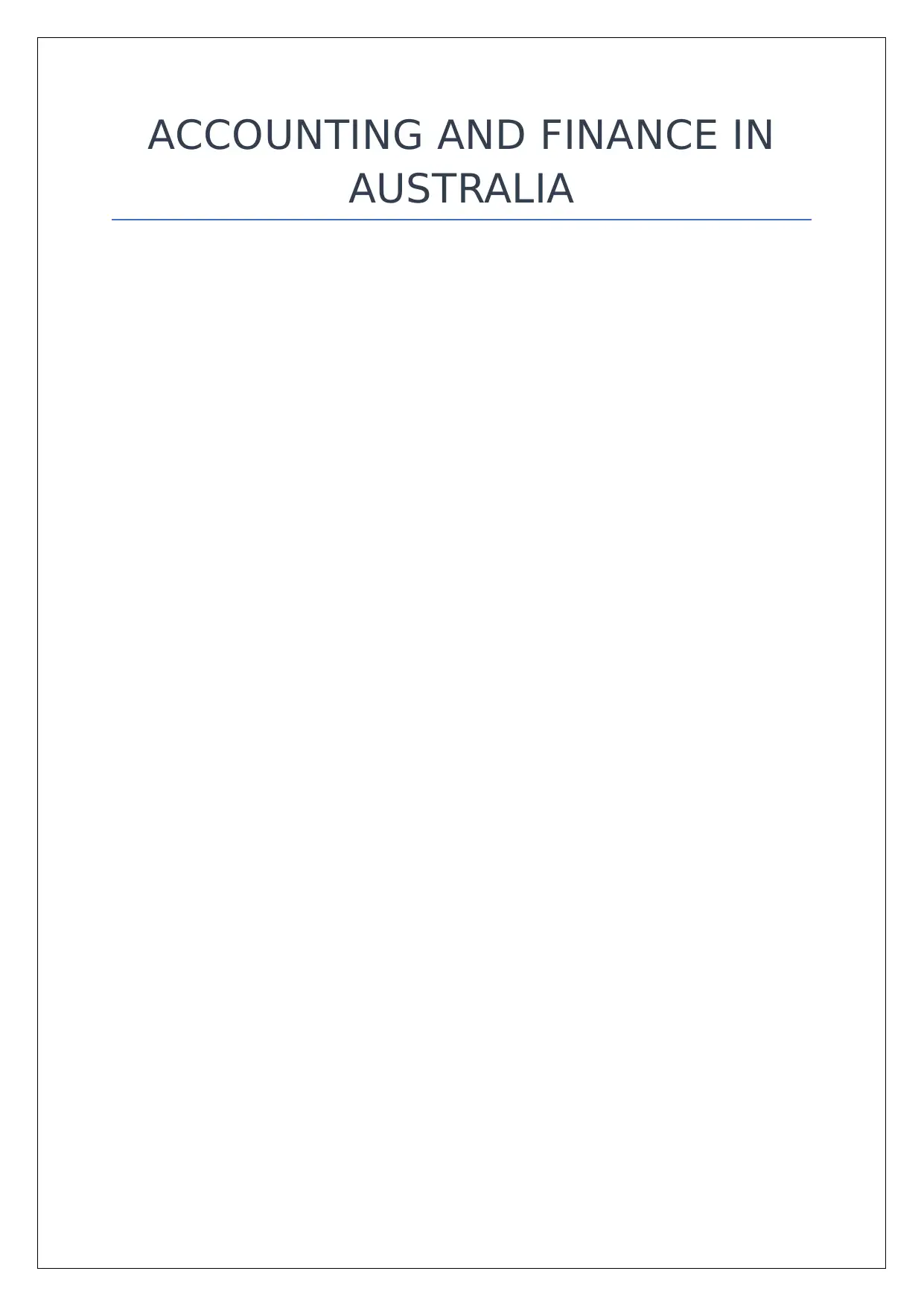
ACCOUNTING AND FINANCE IN
AUSTRALIA
AUSTRALIA
Paraphrase This Document
Need a fresh take? Get an instant paraphrase of this document with our AI Paraphraser
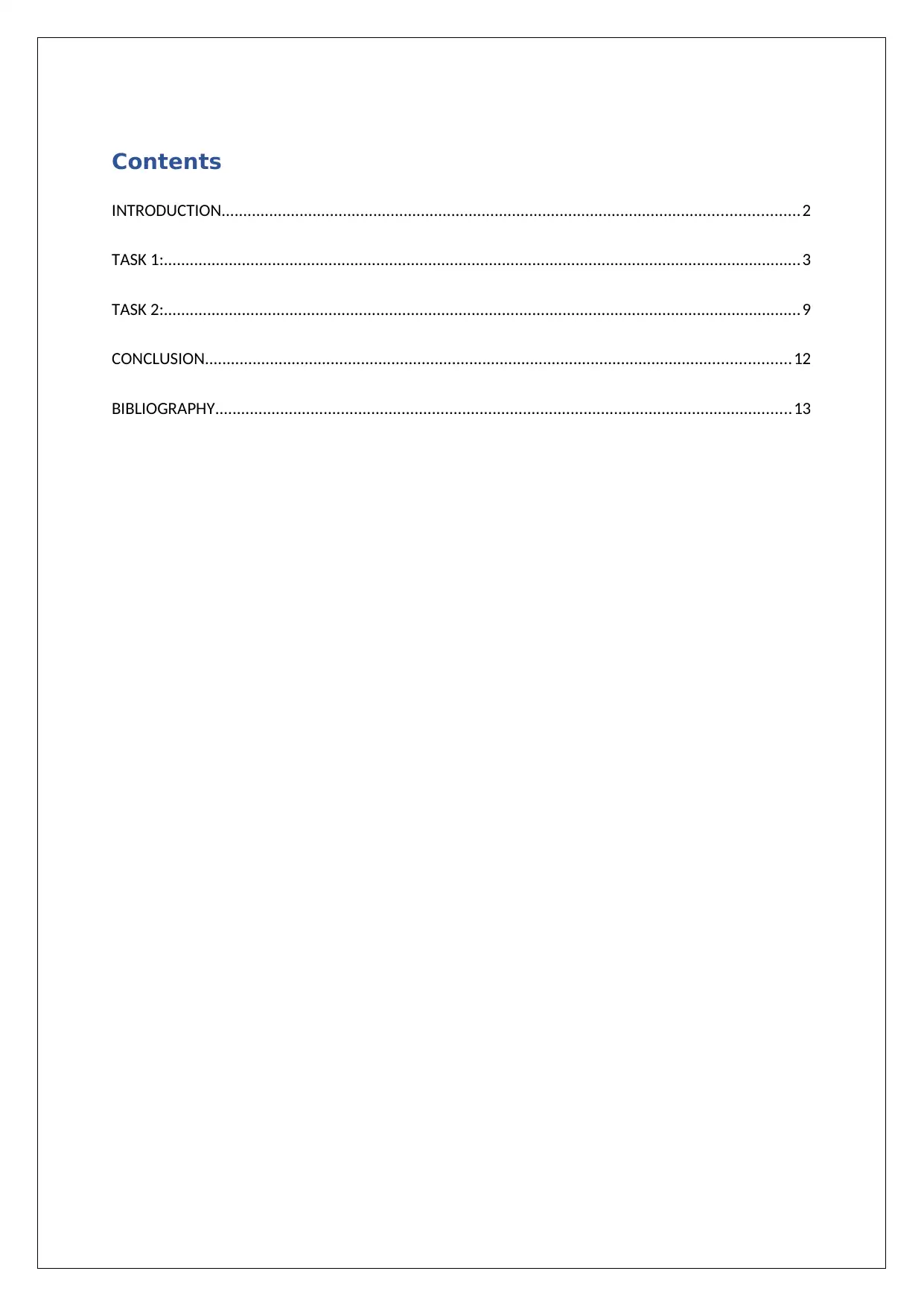
Contents
INTRODUCTION.....................................................................................................................................2
TASK 1:...................................................................................................................................................3
TASK 2:...................................................................................................................................................9
CONCLUSION.......................................................................................................................................12
BIBLIOGRAPHY.....................................................................................................................................13
INTRODUCTION.....................................................................................................................................2
TASK 1:...................................................................................................................................................3
TASK 2:...................................................................................................................................................9
CONCLUSION.......................................................................................................................................12
BIBLIOGRAPHY.....................................................................................................................................13
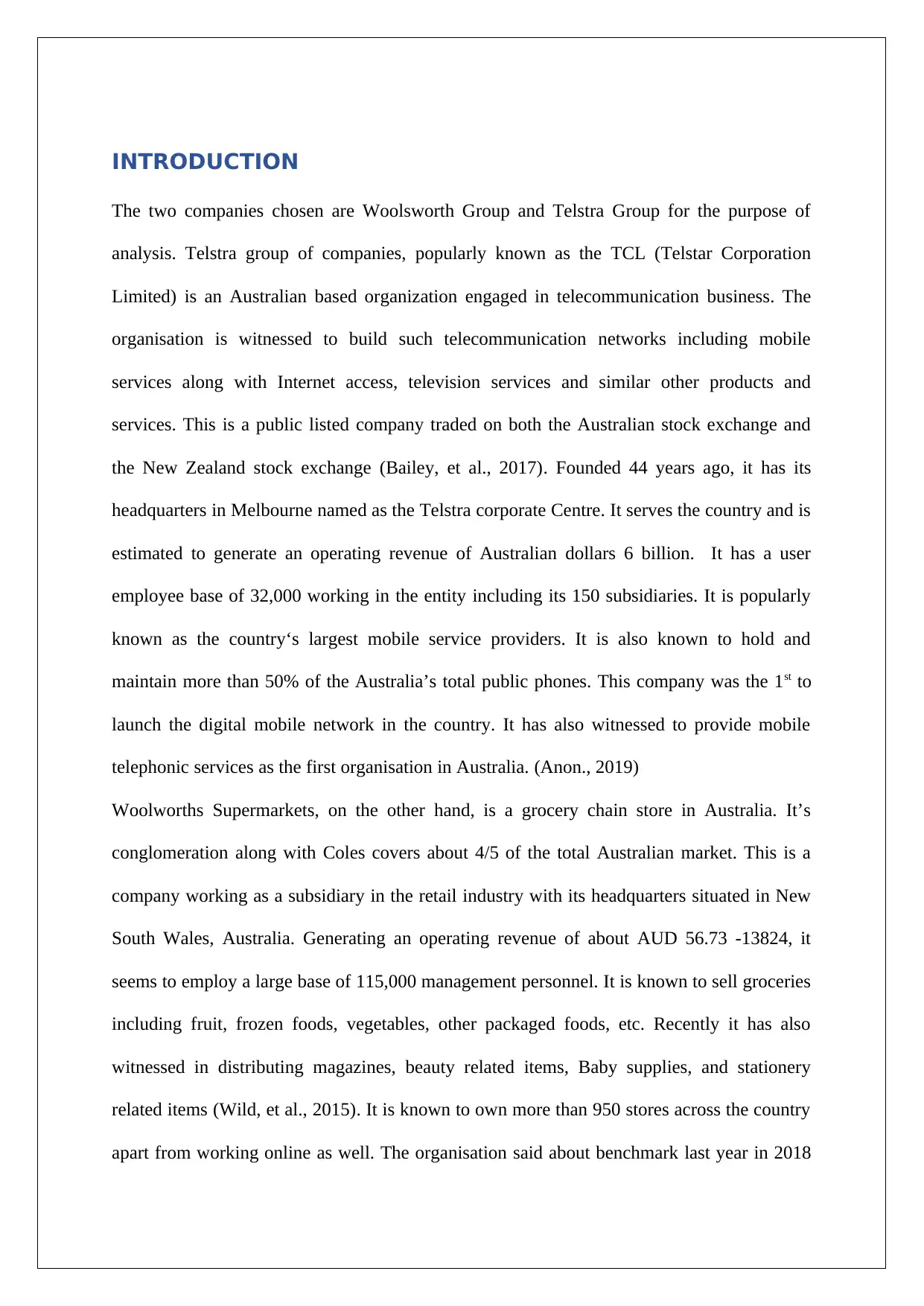
INTRODUCTION
The two companies chosen are Woolsworth Group and Telstra Group for the purpose of
analysis. Telstra group of companies, popularly known as the TCL (Telstar Corporation
Limited) is an Australian based organization engaged in telecommunication business. The
organisation is witnessed to build such telecommunication networks including mobile
services along with Internet access, television services and similar other products and
services. This is a public listed company traded on both the Australian stock exchange and
the New Zealand stock exchange (Bailey, et al., 2017). Founded 44 years ago, it has its
headquarters in Melbourne named as the Telstra corporate Centre. It serves the country and is
estimated to generate an operating revenue of Australian dollars 6 billion. It has a user
employee base of 32,000 working in the entity including its 150 subsidiaries. It is popularly
known as the country‘s largest mobile service providers. It is also known to hold and
maintain more than 50% of the Australia’s total public phones. This company was the 1st to
launch the digital mobile network in the country. It has also witnessed to provide mobile
telephonic services as the first organisation in Australia. (Anon., 2019)
Woolworths Supermarkets, on the other hand, is a grocery chain store in Australia. It’s
conglomeration along with Coles covers about 4/5 of the total Australian market. This is a
company working as a subsidiary in the retail industry with its headquarters situated in New
South Wales, Australia. Generating an operating revenue of about AUD 56.73 -13824, it
seems to employ a large base of 115,000 management personnel. It is known to sell groceries
including fruit, frozen foods, vegetables, other packaged foods, etc. Recently it has also
witnessed in distributing magazines, beauty related items, Baby supplies, and stationery
related items (Wild, et al., 2015). It is known to own more than 950 stores across the country
apart from working online as well. The organisation said about benchmark last year in 2018
The two companies chosen are Woolsworth Group and Telstra Group for the purpose of
analysis. Telstra group of companies, popularly known as the TCL (Telstar Corporation
Limited) is an Australian based organization engaged in telecommunication business. The
organisation is witnessed to build such telecommunication networks including mobile
services along with Internet access, television services and similar other products and
services. This is a public listed company traded on both the Australian stock exchange and
the New Zealand stock exchange (Bailey, et al., 2017). Founded 44 years ago, it has its
headquarters in Melbourne named as the Telstra corporate Centre. It serves the country and is
estimated to generate an operating revenue of Australian dollars 6 billion. It has a user
employee base of 32,000 working in the entity including its 150 subsidiaries. It is popularly
known as the country‘s largest mobile service providers. It is also known to hold and
maintain more than 50% of the Australia’s total public phones. This company was the 1st to
launch the digital mobile network in the country. It has also witnessed to provide mobile
telephonic services as the first organisation in Australia. (Anon., 2019)
Woolworths Supermarkets, on the other hand, is a grocery chain store in Australia. It’s
conglomeration along with Coles covers about 4/5 of the total Australian market. This is a
company working as a subsidiary in the retail industry with its headquarters situated in New
South Wales, Australia. Generating an operating revenue of about AUD 56.73 -13824, it
seems to employ a large base of 115,000 management personnel. It is known to sell groceries
including fruit, frozen foods, vegetables, other packaged foods, etc. Recently it has also
witnessed in distributing magazines, beauty related items, Baby supplies, and stationery
related items (Wild, et al., 2015). It is known to own more than 950 stores across the country
apart from working online as well. The organisation said about benchmark last year in 2018
⊘ This is a preview!⊘
Do you want full access?
Subscribe today to unlock all pages.

Trusted by 1+ million students worldwide
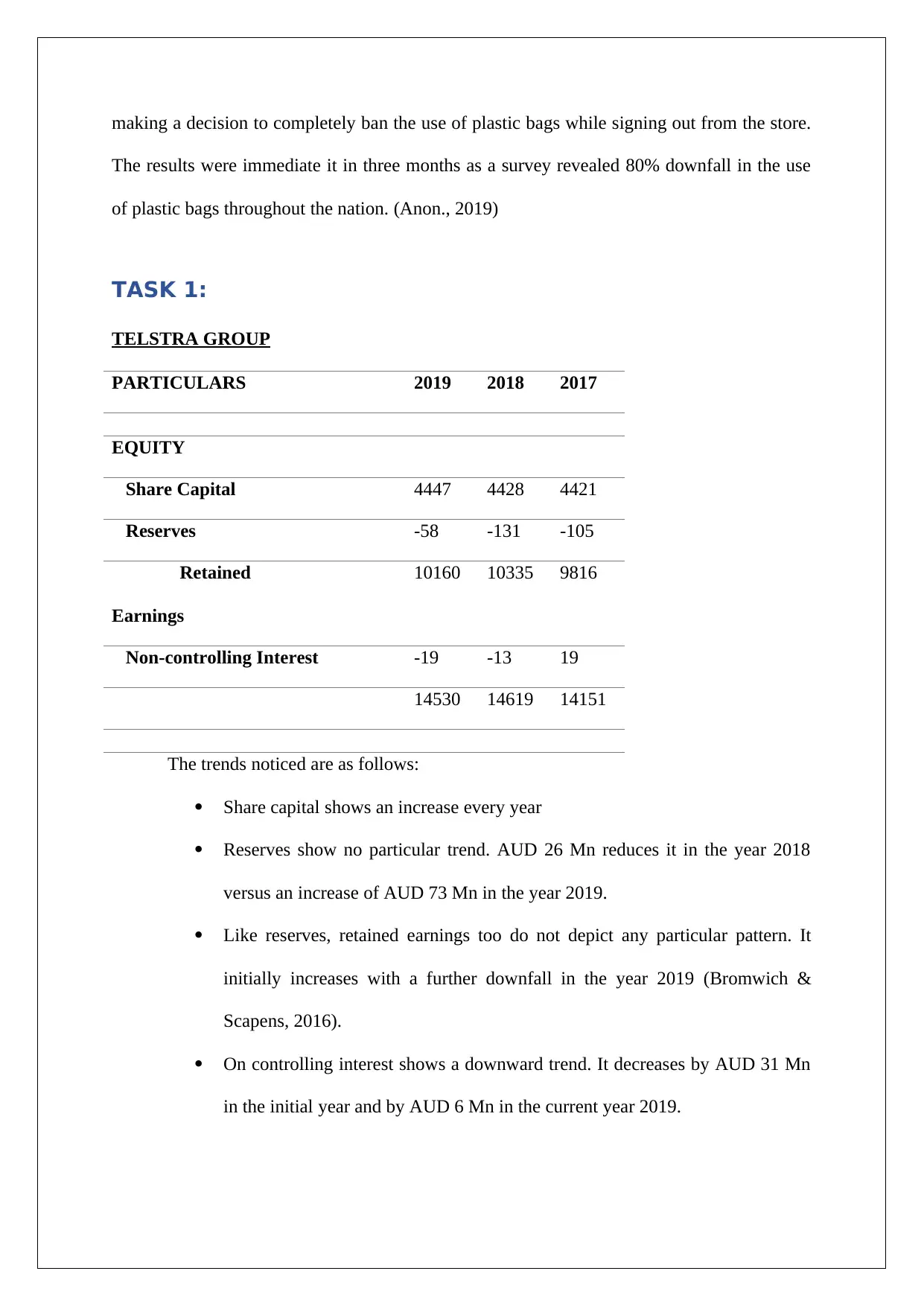
making a decision to completely ban the use of plastic bags while signing out from the store.
The results were immediate it in three months as a survey revealed 80% downfall in the use
of plastic bags throughout the nation. (Anon., 2019)
TASK 1:
TELSTRA GROUP
PARTICULARS 2019 2018 2017
EQUITY
Share Capital 4447 4428 4421
Reserves -58 -131 -105
Retained
Earnings
10160 10335 9816
Non-controlling Interest -19 -13 19
14530 14619 14151
The trends noticed are as follows:
Share capital shows an increase every year
Reserves show no particular trend. AUD 26 Mn reduces it in the year 2018
versus an increase of AUD 73 Mn in the year 2019.
Like reserves, retained earnings too do not depict any particular pattern. It
initially increases with a further downfall in the year 2019 (Bromwich &
Scapens, 2016).
On controlling interest shows a downward trend. It decreases by AUD 31 Mn
in the initial year and by AUD 6 Mn in the current year 2019.
The results were immediate it in three months as a survey revealed 80% downfall in the use
of plastic bags throughout the nation. (Anon., 2019)
TASK 1:
TELSTRA GROUP
PARTICULARS 2019 2018 2017
EQUITY
Share Capital 4447 4428 4421
Reserves -58 -131 -105
Retained
Earnings
10160 10335 9816
Non-controlling Interest -19 -13 19
14530 14619 14151
The trends noticed are as follows:
Share capital shows an increase every year
Reserves show no particular trend. AUD 26 Mn reduces it in the year 2018
versus an increase of AUD 73 Mn in the year 2019.
Like reserves, retained earnings too do not depict any particular pattern. It
initially increases with a further downfall in the year 2019 (Bromwich &
Scapens, 2016).
On controlling interest shows a downward trend. It decreases by AUD 31 Mn
in the initial year and by AUD 6 Mn in the current year 2019.
Paraphrase This Document
Need a fresh take? Get an instant paraphrase of this document with our AI Paraphraser
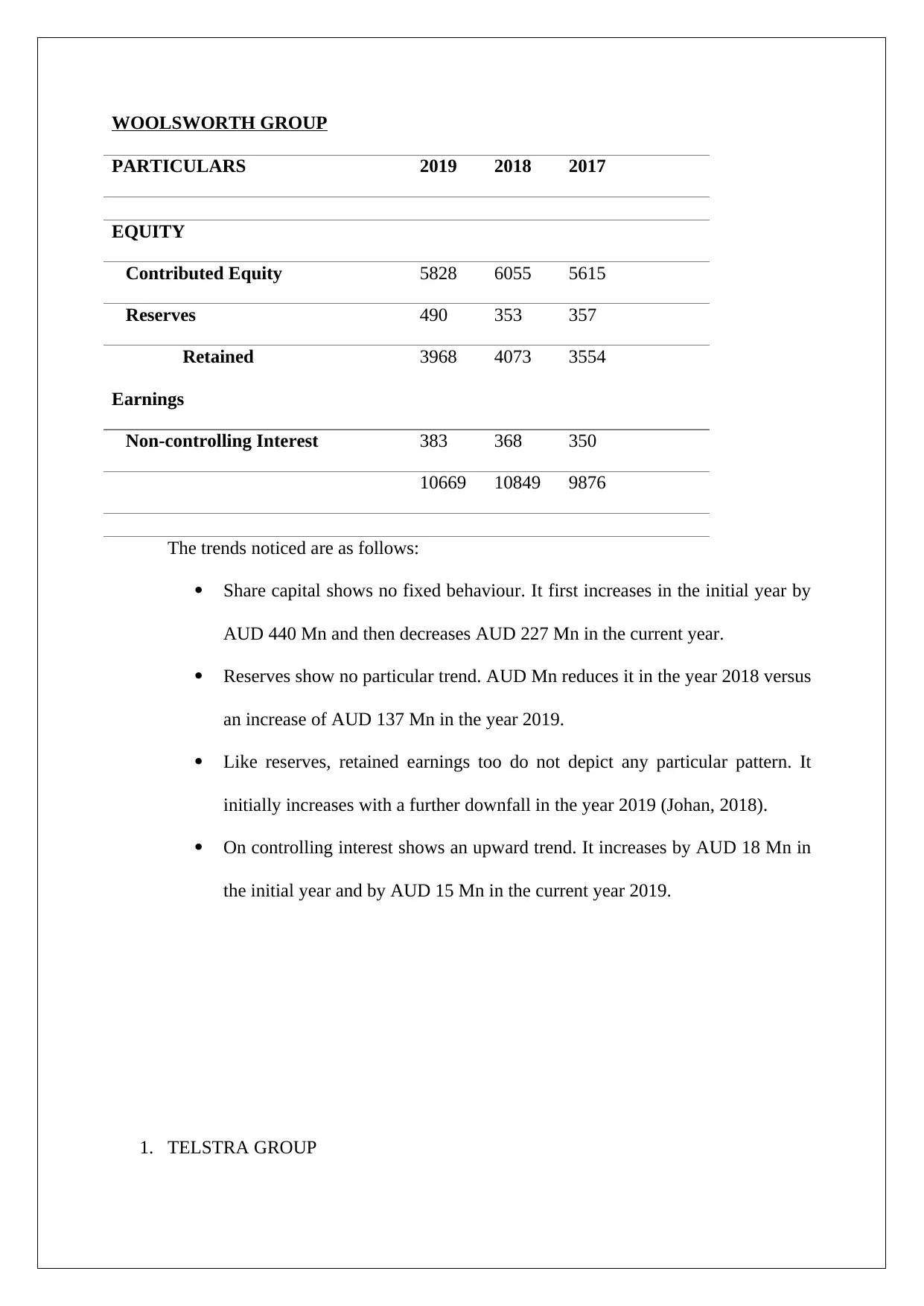
WOOLSWORTH GROUP
PARTICULARS 2019 2018 2017
EQUITY
Contributed Equity 5828 6055 5615
Reserves 490 353 357
Retained
Earnings
3968 4073 3554
Non-controlling Interest 383 368 350
10669 10849 9876
The trends noticed are as follows:
Share capital shows no fixed behaviour. It first increases in the initial year by
AUD 440 Mn and then decreases AUD 227 Mn in the current year.
Reserves show no particular trend. AUD Mn reduces it in the year 2018 versus
an increase of AUD 137 Mn in the year 2019.
Like reserves, retained earnings too do not depict any particular pattern. It
initially increases with a further downfall in the year 2019 (Johan, 2018).
On controlling interest shows an upward trend. It increases by AUD 18 Mn in
the initial year and by AUD 15 Mn in the current year 2019.
1. TELSTRA GROUP
PARTICULARS 2019 2018 2017
EQUITY
Contributed Equity 5828 6055 5615
Reserves 490 353 357
Retained
Earnings
3968 4073 3554
Non-controlling Interest 383 368 350
10669 10849 9876
The trends noticed are as follows:
Share capital shows no fixed behaviour. It first increases in the initial year by
AUD 440 Mn and then decreases AUD 227 Mn in the current year.
Reserves show no particular trend. AUD Mn reduces it in the year 2018 versus
an increase of AUD 137 Mn in the year 2019.
Like reserves, retained earnings too do not depict any particular pattern. It
initially increases with a further downfall in the year 2019 (Johan, 2018).
On controlling interest shows an upward trend. It increases by AUD 18 Mn in
the initial year and by AUD 15 Mn in the current year 2019.
1. TELSTRA GROUP

PARTICULARS 2019 2018 2017
⊘ This is a preview!⊘
Do you want full access?
Subscribe today to unlock all pages.

Trusted by 1+ million students worldwide
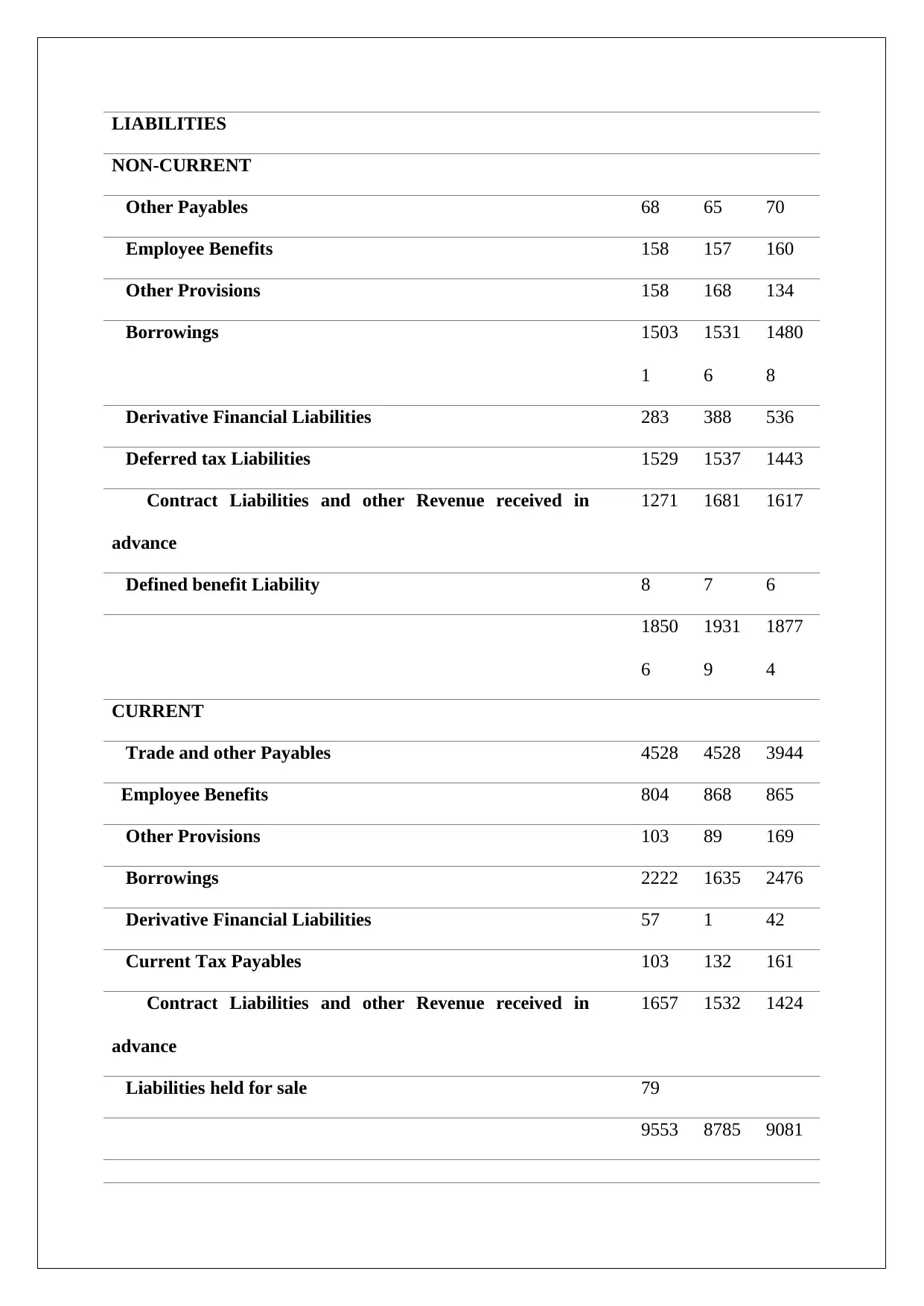
LIABILITIES
NON-CURRENT
Other Payables 68 65 70
Employee Benefits 158 157 160
Other Provisions 158 168 134
Borrowings 1503
1
1531
6
1480
8
Derivative Financial Liabilities 283 388 536
Deferred tax Liabilities 1529 1537 1443
Contract Liabilities and other Revenue received in
advance
1271 1681 1617
Defined benefit Liability 8 7 6
1850
6
1931
9
1877
4
CURRENT
Trade and other Payables 4528 4528 3944
Employee Benefits 804 868 865
Other Provisions 103 89 169
Borrowings 2222 1635 2476
Derivative Financial Liabilities 57 1 42
Current Tax Payables 103 132 161
Contract Liabilities and other Revenue received in
advance
1657 1532 1424
Liabilities held for sale 79
9553 8785 9081
NON-CURRENT
Other Payables 68 65 70
Employee Benefits 158 157 160
Other Provisions 158 168 134
Borrowings 1503
1
1531
6
1480
8
Derivative Financial Liabilities 283 388 536
Deferred tax Liabilities 1529 1537 1443
Contract Liabilities and other Revenue received in
advance
1271 1681 1617
Defined benefit Liability 8 7 6
1850
6
1931
9
1877
4
CURRENT
Trade and other Payables 4528 4528 3944
Employee Benefits 804 868 865
Other Provisions 103 89 169
Borrowings 2222 1635 2476
Derivative Financial Liabilities 57 1 42
Current Tax Payables 103 132 161
Contract Liabilities and other Revenue received in
advance
1657 1532 1424
Liabilities held for sale 79
9553 8785 9081
Paraphrase This Document
Need a fresh take? Get an instant paraphrase of this document with our AI Paraphraser
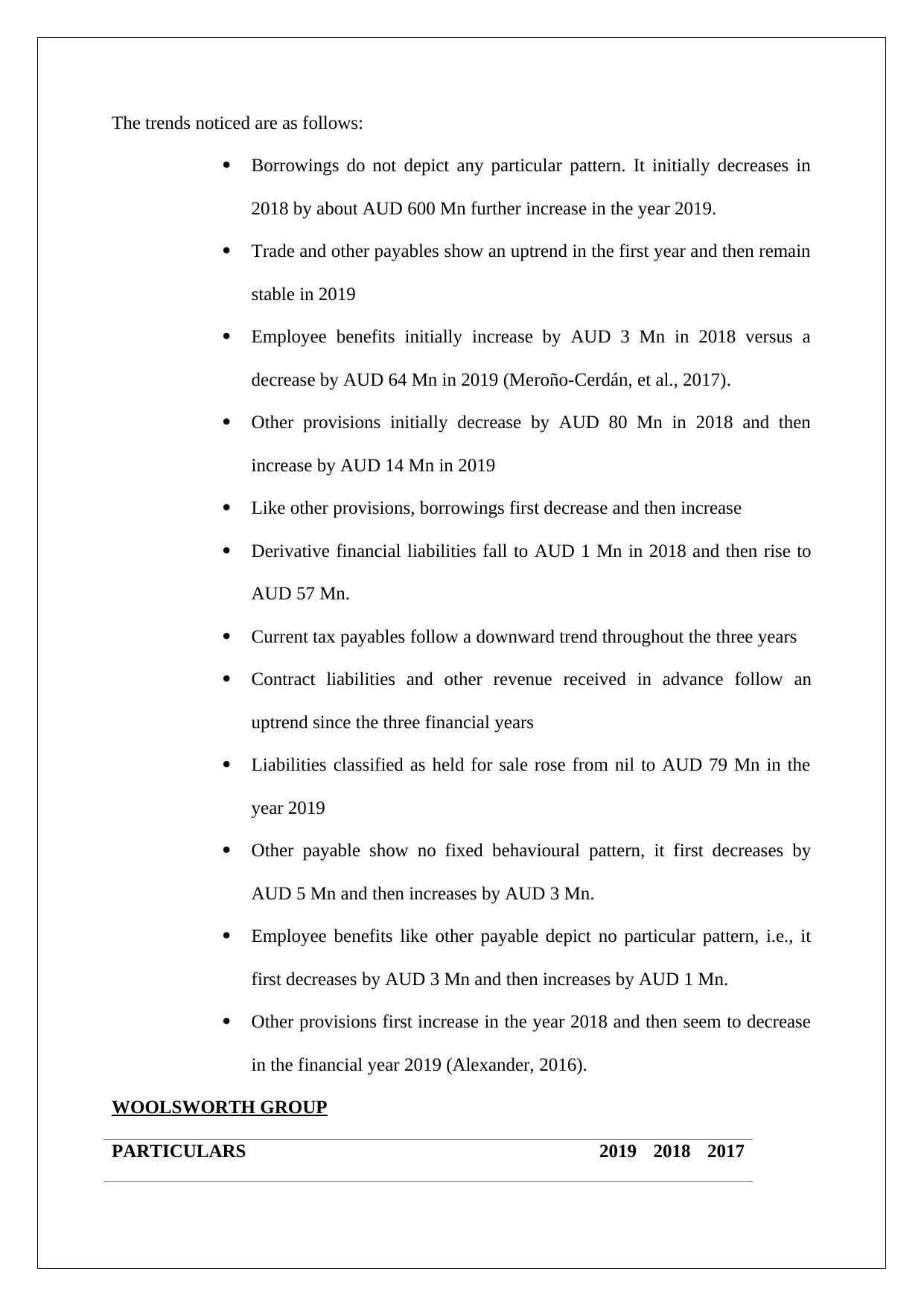
The trends noticed are as follows:
Borrowings do not depict any particular pattern. It initially decreases in
2018 by about AUD 600 Mn further increase in the year 2019.
Trade and other payables show an uptrend in the first year and then remain
stable in 2019
Employee benefits initially increase by AUD 3 Mn in 2018 versus a
decrease by AUD 64 Mn in 2019 (Meroño-Cerdán, et al., 2017).
Other provisions initially decrease by AUD 80 Mn in 2018 and then
increase by AUD 14 Mn in 2019
Like other provisions, borrowings first decrease and then increase
Derivative financial liabilities fall to AUD 1 Mn in 2018 and then rise to
AUD 57 Mn.
Current tax payables follow a downward trend throughout the three years
Contract liabilities and other revenue received in advance follow an
uptrend since the three financial years
Liabilities classified as held for sale rose from nil to AUD 79 Mn in the
year 2019
Other payable show no fixed behavioural pattern, it first decreases by
AUD 5 Mn and then increases by AUD 3 Mn.
Employee benefits like other payable depict no particular pattern, i.e., it
first decreases by AUD 3 Mn and then increases by AUD 1 Mn.
Other provisions first increase in the year 2018 and then seem to decrease
in the financial year 2019 (Alexander, 2016).
WOOLSWORTH GROUP
PARTICULARS 2019 2018 2017
Borrowings do not depict any particular pattern. It initially decreases in
2018 by about AUD 600 Mn further increase in the year 2019.
Trade and other payables show an uptrend in the first year and then remain
stable in 2019
Employee benefits initially increase by AUD 3 Mn in 2018 versus a
decrease by AUD 64 Mn in 2019 (Meroño-Cerdán, et al., 2017).
Other provisions initially decrease by AUD 80 Mn in 2018 and then
increase by AUD 14 Mn in 2019
Like other provisions, borrowings first decrease and then increase
Derivative financial liabilities fall to AUD 1 Mn in 2018 and then rise to
AUD 57 Mn.
Current tax payables follow a downward trend throughout the three years
Contract liabilities and other revenue received in advance follow an
uptrend since the three financial years
Liabilities classified as held for sale rose from nil to AUD 79 Mn in the
year 2019
Other payable show no fixed behavioural pattern, it first decreases by
AUD 5 Mn and then increases by AUD 3 Mn.
Employee benefits like other payable depict no particular pattern, i.e., it
first decreases by AUD 3 Mn and then increases by AUD 1 Mn.
Other provisions first increase in the year 2018 and then seem to decrease
in the financial year 2019 (Alexander, 2016).
WOOLSWORTH GROUP
PARTICULARS 2019 2018 2017
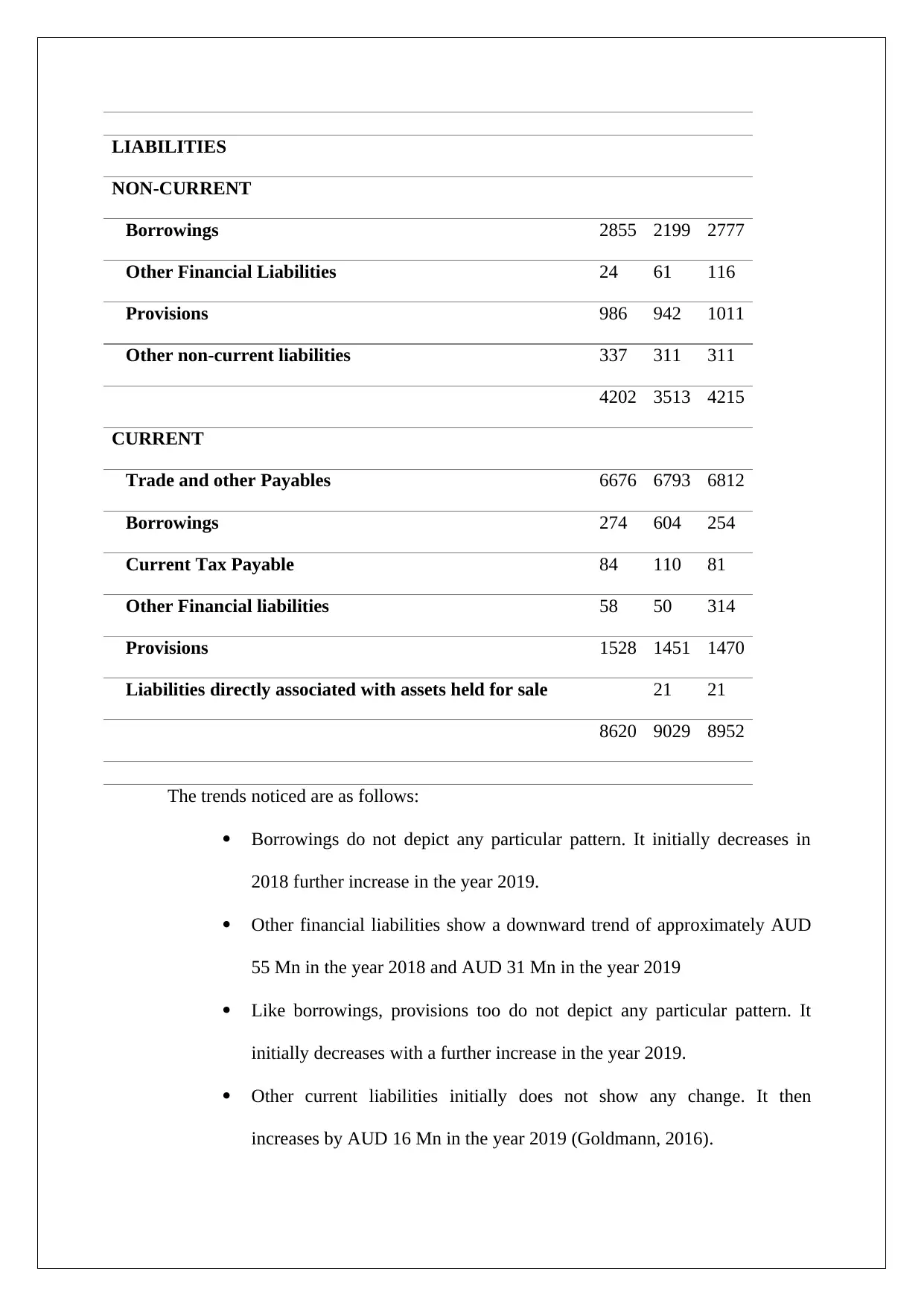
LIABILITIES
NON-CURRENT
Borrowings 2855 2199 2777
Other Financial Liabilities 24 61 116
Provisions 986 942 1011
Other non-current liabilities 337 311 311
4202 3513 4215
CURRENT
Trade and other Payables 6676 6793 6812
Borrowings 274 604 254
Current Tax Payable 84 110 81
Other Financial liabilities 58 50 314
Provisions 1528 1451 1470
Liabilities directly associated with assets held for sale 21 21
8620 9029 8952
The trends noticed are as follows:
Borrowings do not depict any particular pattern. It initially decreases in
2018 further increase in the year 2019.
Other financial liabilities show a downward trend of approximately AUD
55 Mn in the year 2018 and AUD 31 Mn in the year 2019
Like borrowings, provisions too do not depict any particular pattern. It
initially decreases with a further increase in the year 2019.
Other current liabilities initially does not show any change. It then
increases by AUD 16 Mn in the year 2019 (Goldmann, 2016).
NON-CURRENT
Borrowings 2855 2199 2777
Other Financial Liabilities 24 61 116
Provisions 986 942 1011
Other non-current liabilities 337 311 311
4202 3513 4215
CURRENT
Trade and other Payables 6676 6793 6812
Borrowings 274 604 254
Current Tax Payable 84 110 81
Other Financial liabilities 58 50 314
Provisions 1528 1451 1470
Liabilities directly associated with assets held for sale 21 21
8620 9029 8952
The trends noticed are as follows:
Borrowings do not depict any particular pattern. It initially decreases in
2018 further increase in the year 2019.
Other financial liabilities show a downward trend of approximately AUD
55 Mn in the year 2018 and AUD 31 Mn in the year 2019
Like borrowings, provisions too do not depict any particular pattern. It
initially decreases with a further increase in the year 2019.
Other current liabilities initially does not show any change. It then
increases by AUD 16 Mn in the year 2019 (Goldmann, 2016).
⊘ This is a preview!⊘
Do you want full access?
Subscribe today to unlock all pages.

Trusted by 1+ million students worldwide
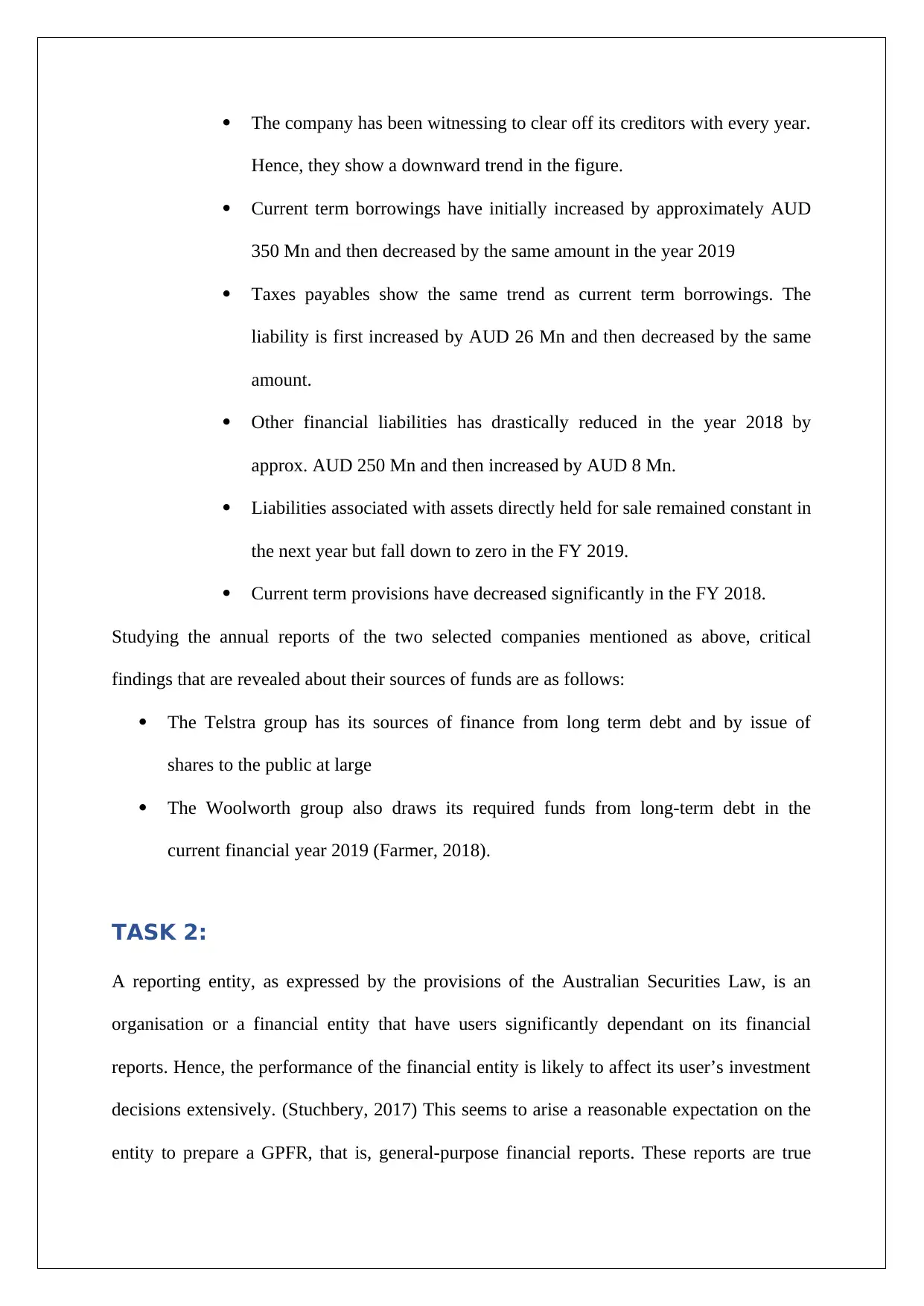
The company has been witnessing to clear off its creditors with every year.
Hence, they show a downward trend in the figure.
Current term borrowings have initially increased by approximately AUD
350 Mn and then decreased by the same amount in the year 2019
Taxes payables show the same trend as current term borrowings. The
liability is first increased by AUD 26 Mn and then decreased by the same
amount.
Other financial liabilities has drastically reduced in the year 2018 by
approx. AUD 250 Mn and then increased by AUD 8 Mn.
Liabilities associated with assets directly held for sale remained constant in
the next year but fall down to zero in the FY 2019.
Current term provisions have decreased significantly in the FY 2018.
Studying the annual reports of the two selected companies mentioned as above, critical
findings that are revealed about their sources of funds are as follows:
The Telstra group has its sources of finance from long term debt and by issue of
shares to the public at large
The Woolworth group also draws its required funds from long-term debt in the
current financial year 2019 (Farmer, 2018).
TASK 2:
A reporting entity, as expressed by the provisions of the Australian Securities Law, is an
organisation or a financial entity that have users significantly dependant on its financial
reports. Hence, the performance of the financial entity is likely to affect its user’s investment
decisions extensively. (Stuchbery, 2017) This seems to arise a reasonable expectation on the
entity to prepare a GPFR, that is, general-purpose financial reports. These reports are true
Hence, they show a downward trend in the figure.
Current term borrowings have initially increased by approximately AUD
350 Mn and then decreased by the same amount in the year 2019
Taxes payables show the same trend as current term borrowings. The
liability is first increased by AUD 26 Mn and then decreased by the same
amount.
Other financial liabilities has drastically reduced in the year 2018 by
approx. AUD 250 Mn and then increased by AUD 8 Mn.
Liabilities associated with assets directly held for sale remained constant in
the next year but fall down to zero in the FY 2019.
Current term provisions have decreased significantly in the FY 2018.
Studying the annual reports of the two selected companies mentioned as above, critical
findings that are revealed about their sources of funds are as follows:
The Telstra group has its sources of finance from long term debt and by issue of
shares to the public at large
The Woolworth group also draws its required funds from long-term debt in the
current financial year 2019 (Farmer, 2018).
TASK 2:
A reporting entity, as expressed by the provisions of the Australian Securities Law, is an
organisation or a financial entity that have users significantly dependant on its financial
reports. Hence, the performance of the financial entity is likely to affect its user’s investment
decisions extensively. (Stuchbery, 2017) This seems to arise a reasonable expectation on the
entity to prepare a GPFR, that is, general-purpose financial reports. These reports are true
Paraphrase This Document
Need a fresh take? Get an instant paraphrase of this document with our AI Paraphraser
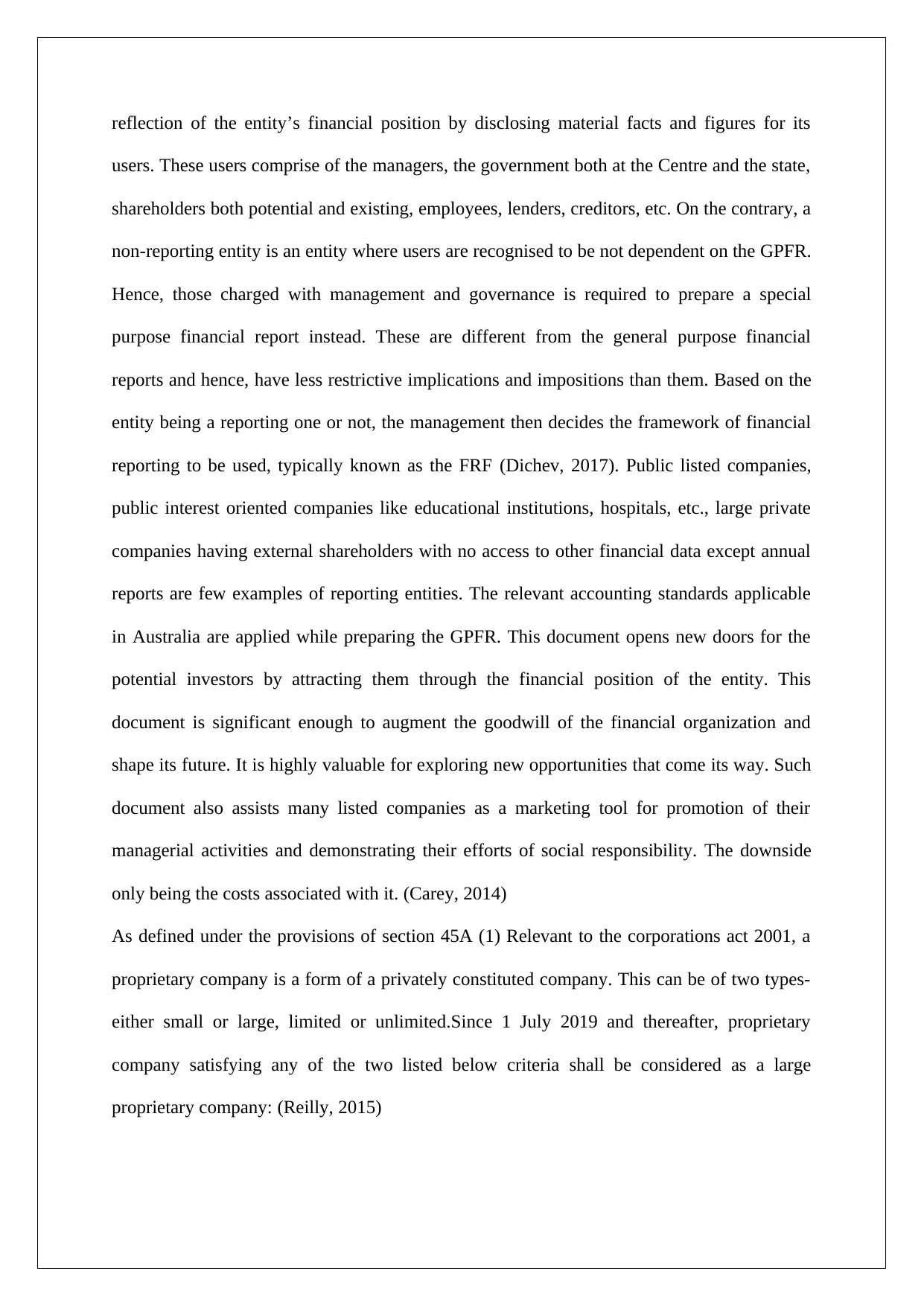
reflection of the entity’s financial position by disclosing material facts and figures for its
users. These users comprise of the managers, the government both at the Centre and the state,
shareholders both potential and existing, employees, lenders, creditors, etc. On the contrary, a
non-reporting entity is an entity where users are recognised to be not dependent on the GPFR.
Hence, those charged with management and governance is required to prepare a special
purpose financial report instead. These are different from the general purpose financial
reports and hence, have less restrictive implications and impositions than them. Based on the
entity being a reporting one or not, the management then decides the framework of financial
reporting to be used, typically known as the FRF (Dichev, 2017). Public listed companies,
public interest oriented companies like educational institutions, hospitals, etc., large private
companies having external shareholders with no access to other financial data except annual
reports are few examples of reporting entities. The relevant accounting standards applicable
in Australia are applied while preparing the GPFR. This document opens new doors for the
potential investors by attracting them through the financial position of the entity. This
document is significant enough to augment the goodwill of the financial organization and
shape its future. It is highly valuable for exploring new opportunities that come its way. Such
document also assists many listed companies as a marketing tool for promotion of their
managerial activities and demonstrating their efforts of social responsibility. The downside
only being the costs associated with it. (Carey, 2014)
As defined under the provisions of section 45A (1) Relevant to the corporations act 2001, a
proprietary company is a form of a privately constituted company. This can be of two types-
either small or large, limited or unlimited.Since 1 July 2019 and thereafter, proprietary
company satisfying any of the two listed below criteria shall be considered as a large
proprietary company: (Reilly, 2015)
users. These users comprise of the managers, the government both at the Centre and the state,
shareholders both potential and existing, employees, lenders, creditors, etc. On the contrary, a
non-reporting entity is an entity where users are recognised to be not dependent on the GPFR.
Hence, those charged with management and governance is required to prepare a special
purpose financial report instead. These are different from the general purpose financial
reports and hence, have less restrictive implications and impositions than them. Based on the
entity being a reporting one or not, the management then decides the framework of financial
reporting to be used, typically known as the FRF (Dichev, 2017). Public listed companies,
public interest oriented companies like educational institutions, hospitals, etc., large private
companies having external shareholders with no access to other financial data except annual
reports are few examples of reporting entities. The relevant accounting standards applicable
in Australia are applied while preparing the GPFR. This document opens new doors for the
potential investors by attracting them through the financial position of the entity. This
document is significant enough to augment the goodwill of the financial organization and
shape its future. It is highly valuable for exploring new opportunities that come its way. Such
document also assists many listed companies as a marketing tool for promotion of their
managerial activities and demonstrating their efforts of social responsibility. The downside
only being the costs associated with it. (Carey, 2014)
As defined under the provisions of section 45A (1) Relevant to the corporations act 2001, a
proprietary company is a form of a privately constituted company. This can be of two types-
either small or large, limited or unlimited.Since 1 July 2019 and thereafter, proprietary
company satisfying any of the two listed below criteria shall be considered as a large
proprietary company: (Reilly, 2015)
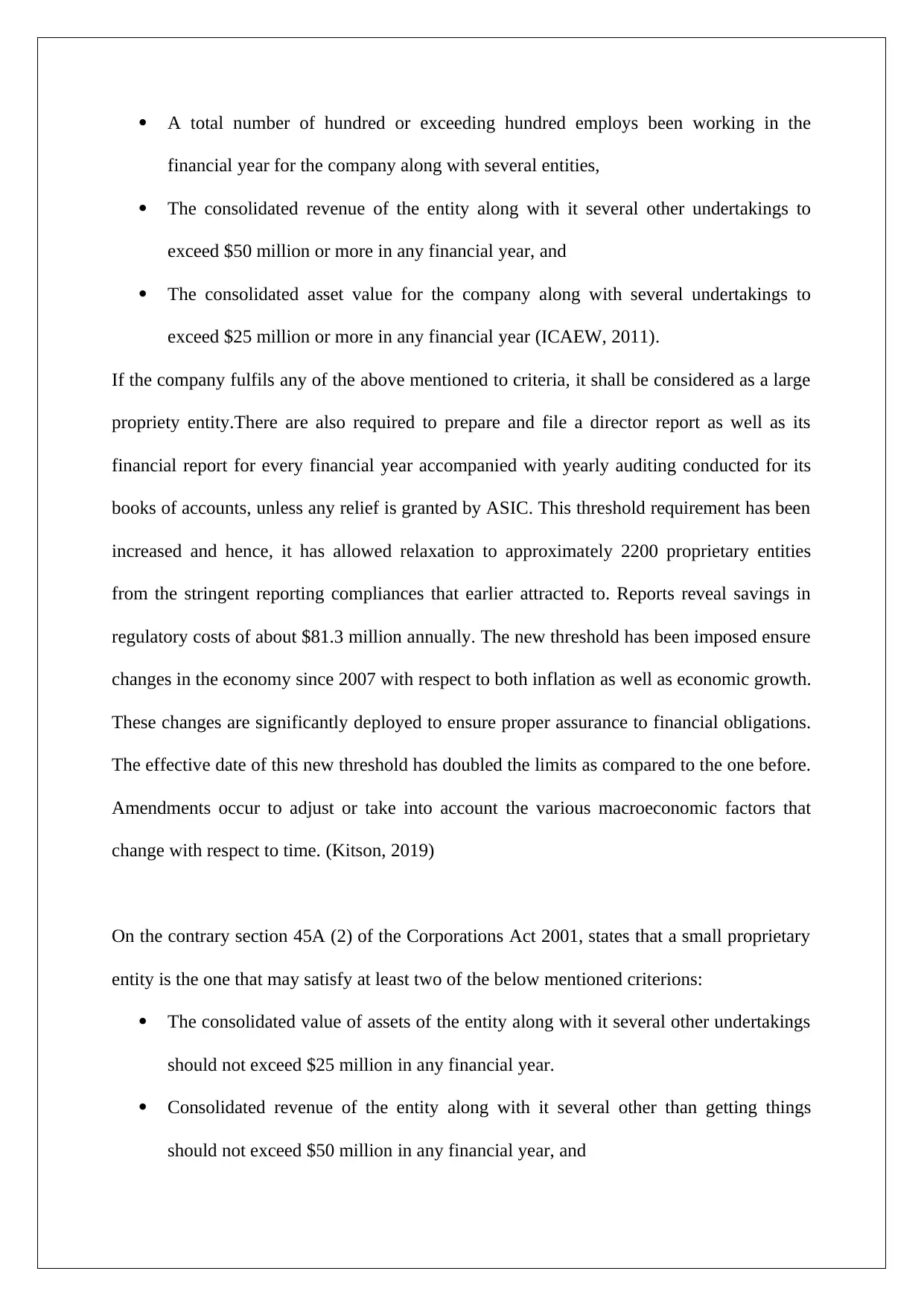
A total number of hundred or exceeding hundred employs been working in the
financial year for the company along with several entities,
The consolidated revenue of the entity along with it several other undertakings to
exceed $50 million or more in any financial year, and
The consolidated asset value for the company along with several undertakings to
exceed $25 million or more in any financial year (ICAEW, 2011).
If the company fulfils any of the above mentioned to criteria, it shall be considered as a large
propriety entity.There are also required to prepare and file a director report as well as its
financial report for every financial year accompanied with yearly auditing conducted for its
books of accounts, unless any relief is granted by ASIC. This threshold requirement has been
increased and hence, it has allowed relaxation to approximately 2200 proprietary entities
from the stringent reporting compliances that earlier attracted to. Reports reveal savings in
regulatory costs of about $81.3 million annually. The new threshold has been imposed ensure
changes in the economy since 2007 with respect to both inflation as well as economic growth.
These changes are significantly deployed to ensure proper assurance to financial obligations.
The effective date of this new threshold has doubled the limits as compared to the one before.
Amendments occur to adjust or take into account the various macroeconomic factors that
change with respect to time. (Kitson, 2019)
On the contrary section 45A (2) of the Corporations Act 2001, states that a small proprietary
entity is the one that may satisfy at least two of the below mentioned criterions:
The consolidated value of assets of the entity along with it several other undertakings
should not exceed $25 million in any financial year.
Consolidated revenue of the entity along with it several other than getting things
should not exceed $50 million in any financial year, and
financial year for the company along with several entities,
The consolidated revenue of the entity along with it several other undertakings to
exceed $50 million or more in any financial year, and
The consolidated asset value for the company along with several undertakings to
exceed $25 million or more in any financial year (ICAEW, 2011).
If the company fulfils any of the above mentioned to criteria, it shall be considered as a large
propriety entity.There are also required to prepare and file a director report as well as its
financial report for every financial year accompanied with yearly auditing conducted for its
books of accounts, unless any relief is granted by ASIC. This threshold requirement has been
increased and hence, it has allowed relaxation to approximately 2200 proprietary entities
from the stringent reporting compliances that earlier attracted to. Reports reveal savings in
regulatory costs of about $81.3 million annually. The new threshold has been imposed ensure
changes in the economy since 2007 with respect to both inflation as well as economic growth.
These changes are significantly deployed to ensure proper assurance to financial obligations.
The effective date of this new threshold has doubled the limits as compared to the one before.
Amendments occur to adjust or take into account the various macroeconomic factors that
change with respect to time. (Kitson, 2019)
On the contrary section 45A (2) of the Corporations Act 2001, states that a small proprietary
entity is the one that may satisfy at least two of the below mentioned criterions:
The consolidated value of assets of the entity along with it several other undertakings
should not exceed $25 million in any financial year.
Consolidated revenue of the entity along with it several other than getting things
should not exceed $50 million in any financial year, and
⊘ This is a preview!⊘
Do you want full access?
Subscribe today to unlock all pages.

Trusted by 1+ million students worldwide
1 out of 15
Your All-in-One AI-Powered Toolkit for Academic Success.
+13062052269
info@desklib.com
Available 24*7 on WhatsApp / Email
![[object Object]](/_next/static/media/star-bottom.7253800d.svg)
Unlock your academic potential
Copyright © 2020–2025 A2Z Services. All Rights Reserved. Developed and managed by ZUCOL.

